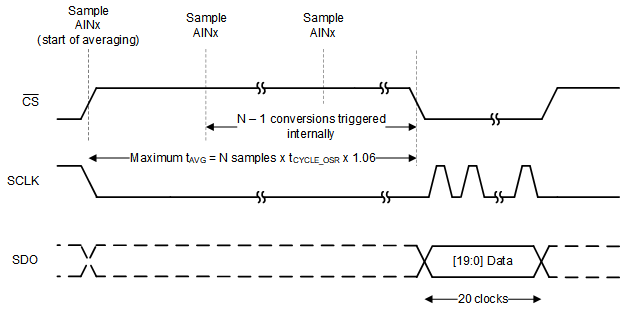ZHCSKW8C February 2020 – September 2023 ADS7066
PRODUCTION DATA
- 1
- 1 特性
- 2 应用
- 3 说明
- 4 Revision History
- 5 Pin Configuration and Functions
- 6 Specifications
-
7 Detailed Description
- 7.1 Overview
- 7.2 Functional Block Diagram
- 7.3 Feature Description
- 7.4 Device Functional Modes
- 7.5 ADS7066 Registers
- 8 Application and Implementation
- 9 Device and Documentation Support
- 10Mechanical, Packaging, and Orderable Information
封装选项
机械数据 (封装 | 引脚)
散热焊盘机械数据 (封装 | 引脚)
- RTE|16
订购信息
7.3.5 Programmable Averaging Filters
The ADS7066 features a programmable averaging filter that can be used to average analog input samples to output a higher resolution measurement. The averaging filter can be enabled by programming the OSR[2:0] bits in the OSR_CFG register to the averaging factor desired. The averaging configuration is common to all analog input channels. As shown in Figure 7-3, the output of the averaging filter is 20 bits long. In manual mode and auto-sequence mode of conversion, only the first conversion for the selected analog input channel must be initiated by the host, as shown in Figure 7-3; any remaining conversions are generated internally. The time (tAVG) required to complete the averaging operation is determined by the sampling speed and number of samples to be averaged; see the Oscillator and Timing Control section for more details. After completion, the averaged 20-bit result, as shown in Figure 7-3, can be read-out. For information on the programmable averaging filters and performance results see the Resolution-Boosting ADS7066 Using Programmable Averaging Filter application report.
In autonomous mode of operation, samples from analog input channels that are enabled in the AUTO_SEQ_CH_SEL register are averaged sequentially.
 Figure 7-3 Averaged Output Data
Figure 7-3 Averaged Output Data